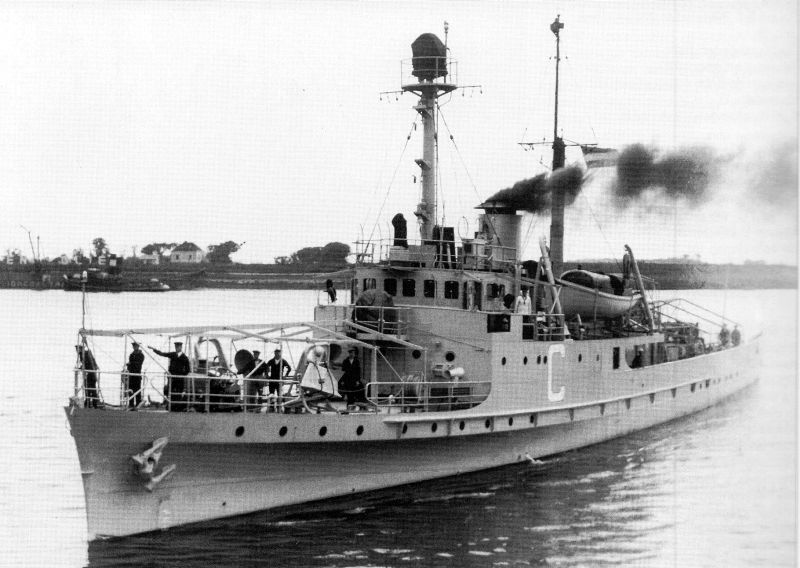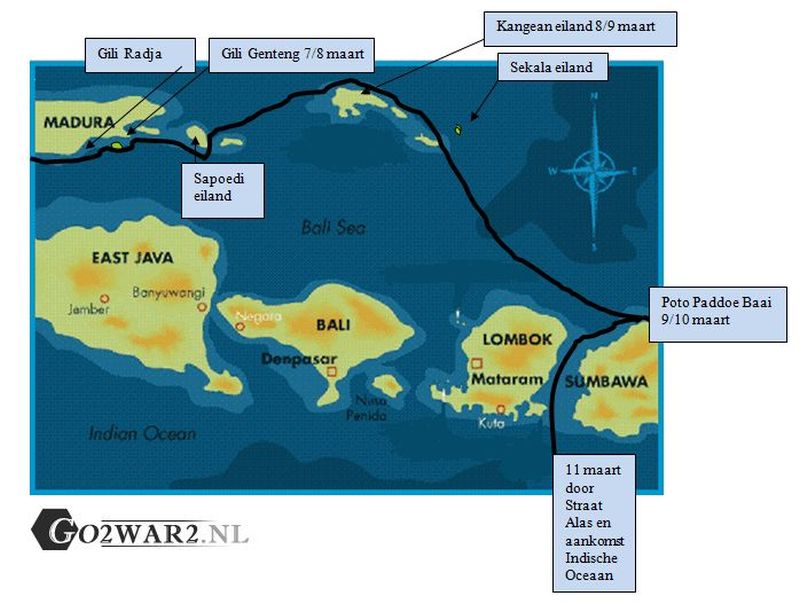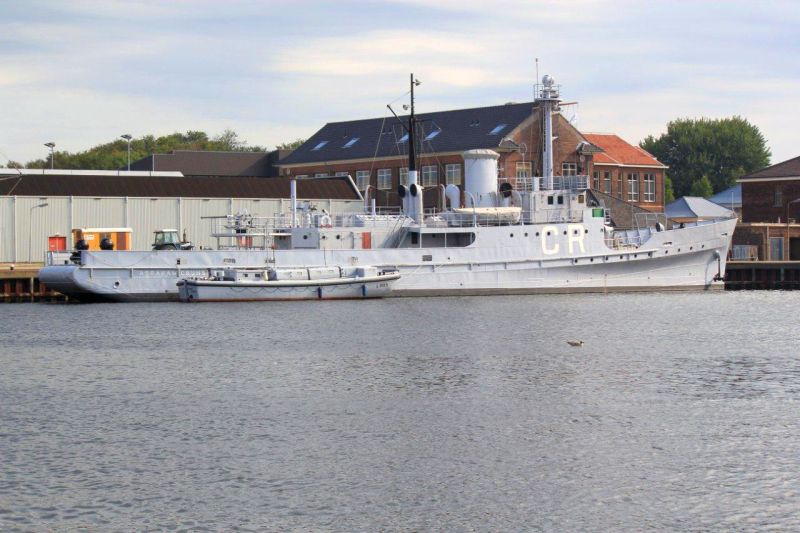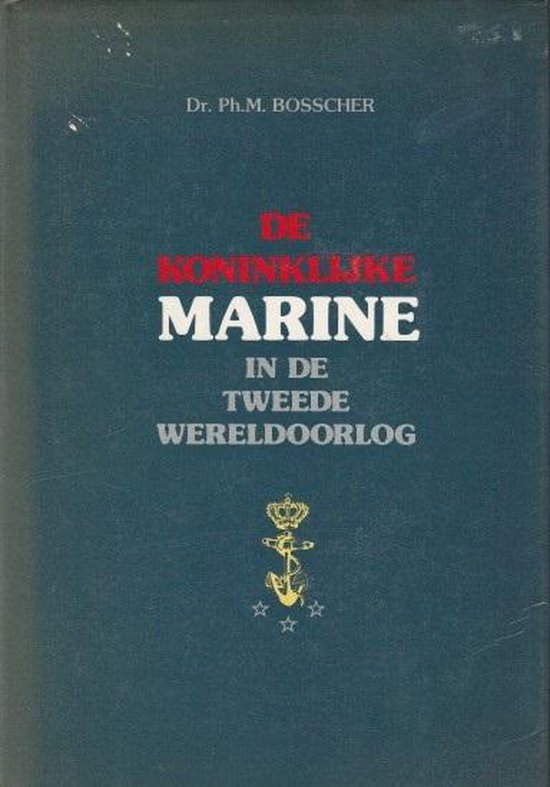Introduction
Early March 1942 it was all too clear that the last stronghold in the Dutch East-Indies, Java, was to fall into Japanese hands very soon. The Battle in the Java Sea was lost and all capital Dutch Royal Navy ships were sunk including the Dutch flagship, the light cruiser Hr. Ms. De Ruyter. The remaining, smaller ships received the order to withdraw to Australia or Colombo, Ceylon. If this was, due to a short range capability, impossible the ships were to be destroyed. Not any ship was allowed to fall into the hands of the enemy under any circumstance.
Among the smaller ships in Java at that time, there were four steel minesweepers of the Jan van Amstel-class. Together they formed the 2nd Minesweeper Division under command of Lieutenant Commander J.R.L. Lebeau. The division consisted of Hr. Ms. Jan van Amstel, Hr. Ms. Pieter de Bitter, Hr. Ms. Abraham Crijnssen and Hr. Ms. Eland Dubois and was stationed in Surabaya, the main naval base in northeast Java.
As early as February 17th 1942, the 2nd Minesweeper Division had been issued the order by the Dutch navy commander, Rear Admiral P. Koenraad, to attempt to escape after receiving the code KPX. But early March the commanders of the minesweepers still had not yet received clear instructions what to do when the order KPX was given while the personnel of the navy establishment in Surabaya was already busy destroying the harbor facilities. There was tremendous chaos in Surabaya at that period. The Japanese controlled both the sea and the sky around and above Java and escaping became more difficult with every hour that passed.
Definitielijst
- cruiser
- A fast warship with 8,000 – 15,000 ton displacement, capable to perform multiple tasks such as reconnaissance, anti-aircraft defence and convoy protection.
Images
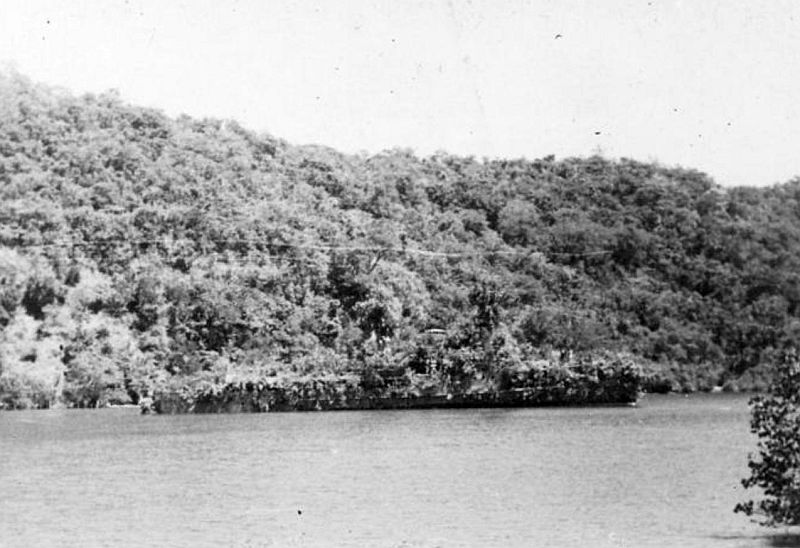 Hr. Ms. Abraham Crijnssen disguised as a tropical island Source: Australian War Memorial.
Hr. Ms. Abraham Crijnssen disguised as a tropical island Source: Australian War Memorial.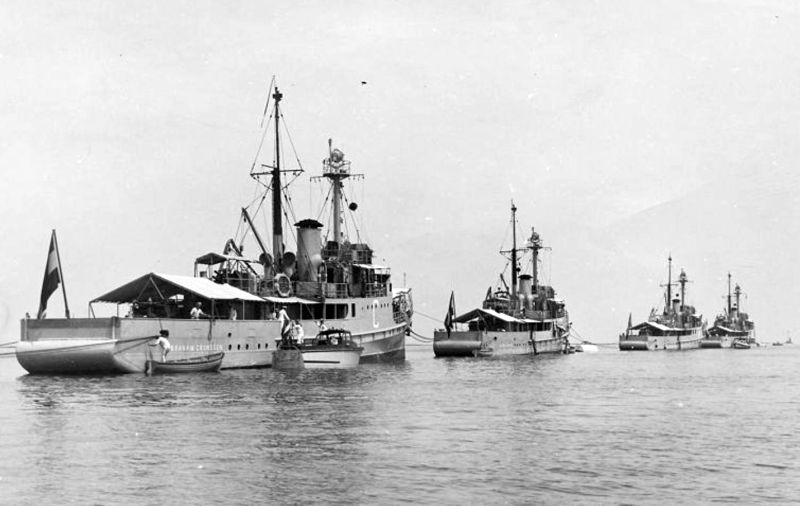 2nd Minesweeping Division at Surabaya. Source: Marine Museum.
2nd Minesweeping Division at Surabaya. Source: Marine Museum.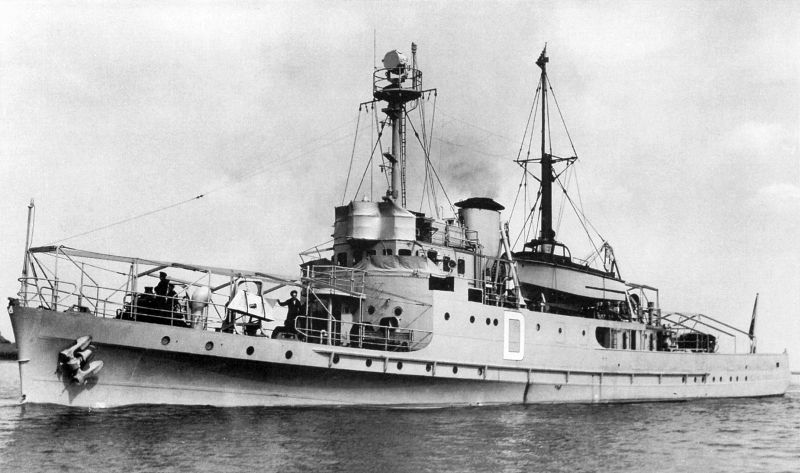 Hr. Ms. Eland Dubois, sistership of Hr. Ms. Abraham Crijnssen. Source: Wikipedia.
Hr. Ms. Eland Dubois, sistership of Hr. Ms. Abraham Crijnssen. Source: Wikipedia.Preparation
The commanding officer of Hr. Ms. Abraham Crijnssen, Lieutenant Commander A. van Miert, had already begun the preparations of an escape attempt at that time. On his order the 460 ton minesweeper was painted in different camouflage colors that provided distorting effects to the 57 meter long ship. Furthermore he had the ship camouflaged with nets, tree branches and leaves so from the air the ship looked like a tropical island. During an all hands on deck the commander told his crew that they had the choice to participate in the dangerous escape attempt or to disembark. About half of the 45 crewmembers decided to leave, including all the indigenous personnel.
2nd Minesweeper Division commander Lebeau organized a meeting with all his commanding officers and their replacements. He told them that they could make up their own mind about any escape attempt. With this information he gave his commanding officers the choice to destroy their own ship and not to try to escape. This was in fact contradictory to the order KPX and would not remain without consequences.
On March 6th 1942, Rear Admiral Koenraad gave the order KPX but only three out of the four minesweepers would leave port. Lieutenant Commander J.P.A. Dekker, commanding officer of Hr. Ms. Pieter de Bitter, was of the opinion that he could not take the responsibility to endanger his crew during an escape and decided to destroy his own ship. Two time bombs were used to sink the minesweeper at the cruiser quay at the navy establishment at Surabaya. Rear Admiral Koenraad was on board the submarine Hr. Ms. K XII at that time and he heard the underwater explosions. He started an investigation immediatly and informed by telegram that, if commanding officer Dekker of Hr. Ms. Pieter de Bitter had sank his ship without a valid reason, he was to be executed.
It is not clear if the remaining commanding officers of the 2nd Minesweeper Division decided to attempt their escape for this reason, but it is clear that they were to give it a go.
Definitielijst
- cruiser
- A fast warship with 8,000 – 15,000 ton displacement, capable to perform multiple tasks such as reconnaissance, anti-aircraft defence and convoy protection.
Images
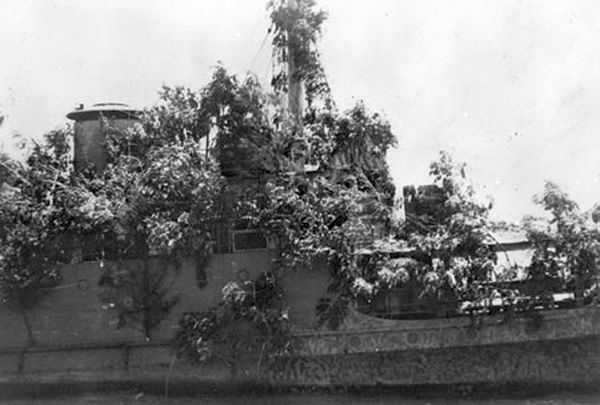 Hr. Ms. Abraham Crijnssen covered in branches. Source: Australian War Memorial.
Hr. Ms. Abraham Crijnssen covered in branches. Source: Australian War Memorial.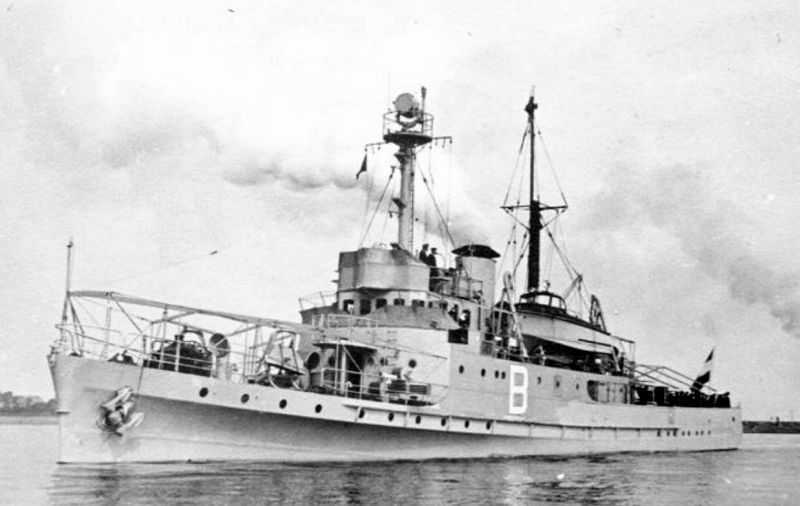 Hr. Ms. Pieter de Bitter. Source: Marine Museum.
Hr. Ms. Pieter de Bitter. Source: Marine Museum.The escape
Hr. Ms. Jan van Amstel, under commanding officer Lieutenant C. de Greeuw and Hr. Ms. Eland Dubois, under commanding officer Lieutenant H. de Jong left together but were not prepared well enough. The minesweepers were not camouflaged and the Eland Dubois had a problem with one of the boilers. Besides that, the two ships lacked enough fuel to make it to Australia. In the early morning of March 7th the two sister ships reached the roadstead of Gili Radja and anchored there to wait for the next sundown.
Hr. Ms. Abraham Crijnssen left the harbor of Surabaya in the evening of March 6th at about 9:30 pm and was very well camouflaged and topped off to the maximum of 110 tons of fuel. The minesweeper also left in easterly direction, through Strait Madura, and reached the roadstead of Gili Radja in the early morning of March 7th as well. Here she met her sister ships but commanding officer Van Miert decided to proceed to the roadstead of Gili Genteng because he did not want to be near the Jan van Amstel and the Eland Dubois because of their lack of camouflage.
This decision proved to be right because Hr. Ms. Jan van Amstel and Hr. Ms. Eland Dubois were spotted by a Japanese plane during the day on March 7th. Because a lot of crewmembers had deserted and because of the boiler problem aboard the Eland Dubois it was decided on March 8th that the latter would be sunk and that the crewmembers would hop over to the Jan van Amstel. By opening the outboard valves and by detonating a depth charge the job was done in the vicinity of Gili Genteng. Hr. Ms. Jan van Amstel was subsequently camouflaged and took off in easterly direction in the evening of March 8th. After a short while the minesweeper was spotted by the Japanese destroyer Arashio which sank the Dutch ship in Strait Madura. 23 Of the crew were killed during the sinking including the commanding officer of the Eland Dubois.
During the day on March 7th the camouflage on board Hr. Ms. Abraham Crijnssen was refreshed as much as possible. Immediately after sundown the Dutch minesweeper left from Gili Genteng with an average speed of 12 knots in easterly direction. Taking advantage of the cover of the coastlines as much as possible the Crijnssen steamed right under the islands Sapoedi and Raas and then, between the coral reefs of Goa-Goa and Karang Takat, further in northeasterly direction to the Kangean Islands. On the early Sunday morning of March 8th the camouflaged minesweeper arrived at the north shores of Kangean Island and anchored there. Again the branches and leaves were replaced as much as possible by fresh green and the crew paid extra attention to the local plant species.
That night at 6:45 pm the dangerous journey was continued in easterly direction and keeping course north of the Kangean Islands the course was changed into southeasterly direction between the islands Pageroean and Sekala when the Kangeans were passed. After that, the dangerous passage of the Bali Sea was begun in the direction of Sumbawa. On the open sea the risk of being spotted was at its most because no cover by the coast line at all was provided. The next morning though, the ship could be anchored safely in de bay of Poto Paddu on the north shores of the island Sumbawa and immediately the crew went to work to keep the camouflage in good condition.
During the morning of March 9th, some crew members went to shore with the motor dingy to collect drinking water and information from the local people. From delegates of the local sultan and from a representative of the Koninklijke Paketvaart Maatschappij (the Dutch inter island commercial shipping company) they learned that no Japanese troops were sighted on the island yet and that no Japanese planes had been seen during the last four days. This was very reassuring news because it proved that the Japanese were looking for the escaped minesweeper at the wrong place or that they were not looking at all. The enemy aircraft had in fact just spotted two hostile minesweepers on March 7th, which were both sunk.
After stocking up on the supplies of drinking water and coconuts the ship left after sundown and at 10:15 pm the entrance of Strait Alas was reached. With a speed of 13 knots the strait was entered and then commanding officer Van Miert slowed down to 10 knots to save fuel. During the day the minesweeper took cover again under the coastline and for the last time the camouflage was refreshed. In the early evening of March 10th the dangerous passage of the strait was pursued in southern direction.
De next day the minesweeper reached the end of the strait and entered the vast openness of the Indian Ocean. From here the Dutch ship kept her southern course in the direction of Australia. During the crossing of the ocean the camouflage was thrown overboard because it did not serve much purpose anymore and would only slow the vessel down. On Friday morning March 13th the Northwest Cape of Australia came into sight. Maintaining the economical speed of 10 knots the ship kept its course with the shorelines of the continent. Commanding officer Van Miert wanted to try to sail as far as possible with the available amount of fuel; thus Shark Bay and Dirk Hartog Island were ignored and the minesweeper pushed on. Around noon on March 15th, Hr. Ms. Abraham Crijnssen arrived at Geraldton, Western Australia. Finally the exhausted crew could take a break. The ship was resupplied and fuel was taken in. A few days later the fortunate ship left for Fremantle, the harbor city near Perth. Here the steel minesweeper arrived on March 20th.
Definitielijst
- destroyer
- Very light, fast and agile warship, intended to destroy large enemy ships by surprise attack and eliminating them by using torpedoes.
Images
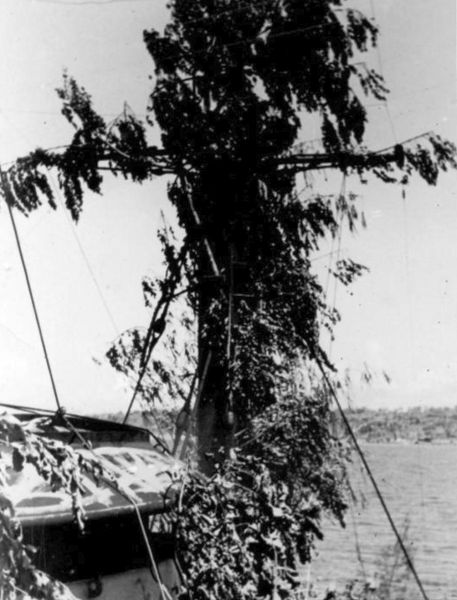 Camouflaged mast of Hr. Ms. Abraham Crijnssen. Source: Australian War Memorial.
Camouflaged mast of Hr. Ms. Abraham Crijnssen. Source: Australian War Memorial.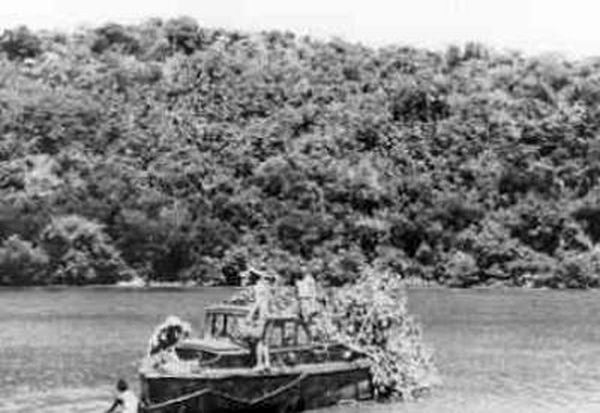 Fresh branches and leaves are brought to Hr. Ms. Abraham Crijnssen. Source: Australian War Memorial.
Fresh branches and leaves are brought to Hr. Ms. Abraham Crijnssen. Source: Australian War Memorial.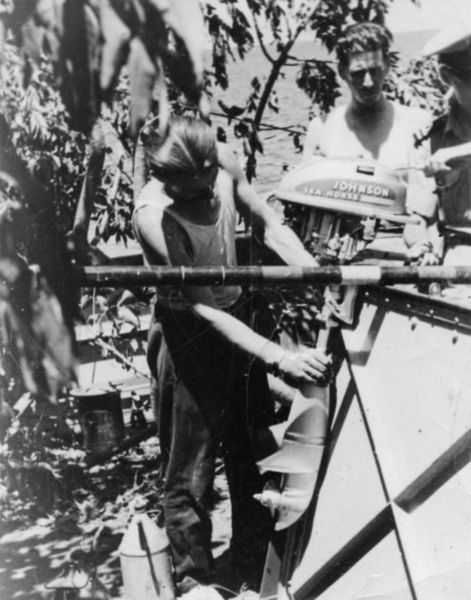 Live on board the camouflaged minesweeper. Source: Marine Museum.
Live on board the camouflaged minesweeper. Source: Marine Museum.Conclusion
The risky and eventful journey was brought to a successful end. The perseverance of the undermanned crew and the energetic leadership of commanding officer Van Miert during the escape proved to be sufficient to end the attempt to escape successful. Making the most of the camouflage in de midst of the Indonesian tropical islands they succeeded in bringing their ship to a safe haven. From here the war went on and a lot more dangerous missions had to be undertaken, but that was of later concern.
The commanding officer of Hr. Ms. Abraham Crijnssen and nine of his crew were decorated, for their courage displayed during the escape, with the Cross of Merits.
Lieutenant Commander A. van Miert was commanding officer of Hr. Ms. Abraham Crijnssen till August 25th 1942. Then he was transferred to the gunboat Hr. Ms. Soemba where he was the first officer. From August 5th 1943 he was acting commander of this ship when commanding officer Sterkenburg was killed in action. From November 24th 1944 he was commanding officer of the sister ship of the Soemba, Hr. Ms. Flores, and from January 16th 1945 he was in command of the modern minelayer Hr. Ms. Wilem van der Zaan. In 1967 he was honorably discharged from the navy and retired in the rank of Commander.
Lieutenant Commander Dekker, commanding officer of Hr. Ms. Pieter de Bitter, suffered three years in a Japanese prisoner of war camp. He was court-martialed after the war and on April 13th 1948 he was dishonorably discharged from the navy.
The Abraham Crijnssen is now a museum ship in Den Helder, in the Netherlands and the last surviving Dutch warship which fought in the Second World War.
Images
Information
- Article by:
- Peter Kimenai
- Translated by:
- Peter Kimenai
- Published on:
- 27-11-2012
- Last edit on:
- 30-09-2024
- Feedback?
- Send it!
Related books
Sources
- BEZEMER, K.W.L., Verdreven doch niet verslagen, Uitgeversmaatschappij W. de Haan N.V., Hilversum, 1967.
- BEZEMER, K.W.L., Zij vochten op de zeven zeeën, Uitgeversmaatschappij W. De Haan N.V., Zeist, 1964.
- BOSSCHER, PH., M., De Koninklijke Marine in de Tweede Wereldoorlog deel 2, Uitgeverij T. Wever B.V., Franeker, 1986.
- BOSSCHER, PH., M., De Koninklijke Marine in de Tweede Wereldoorlog deel 3, Uitgeverij T. Wever B.V., Franeker, 1990.
